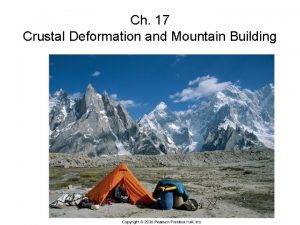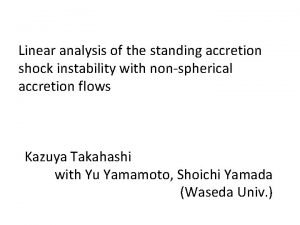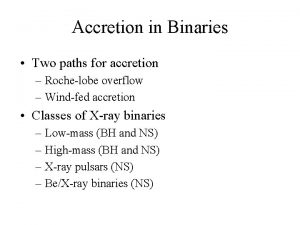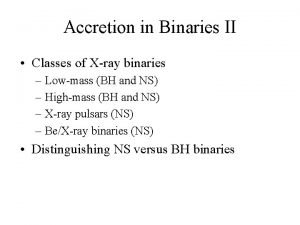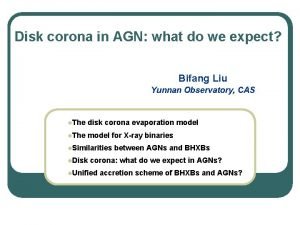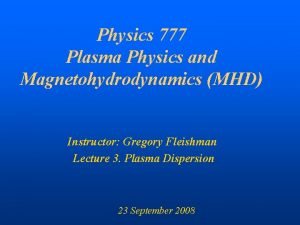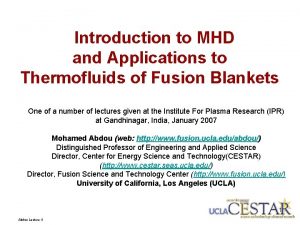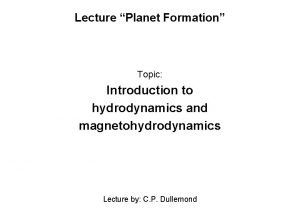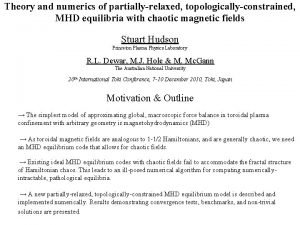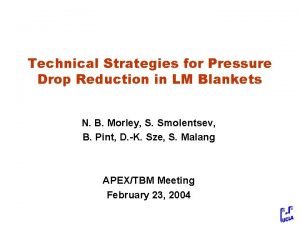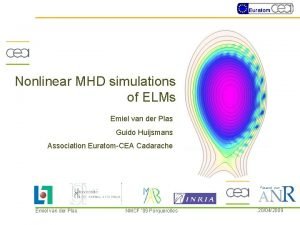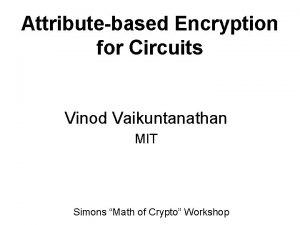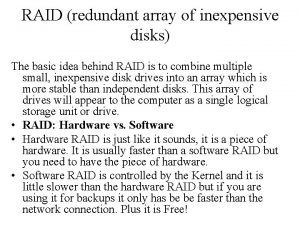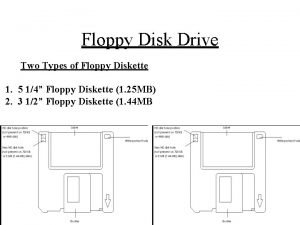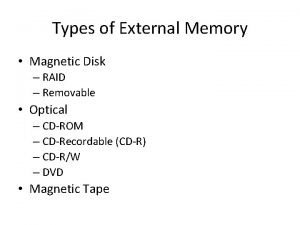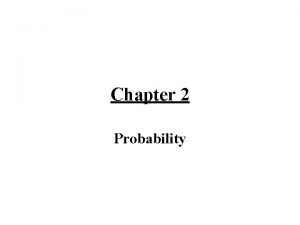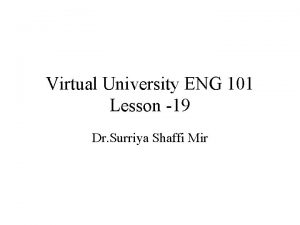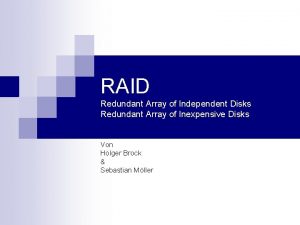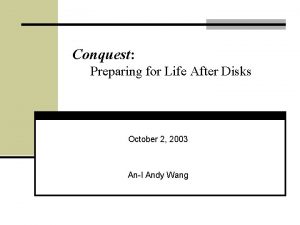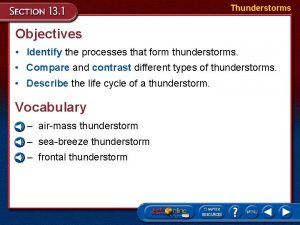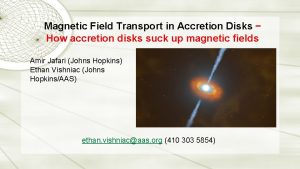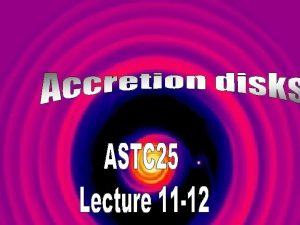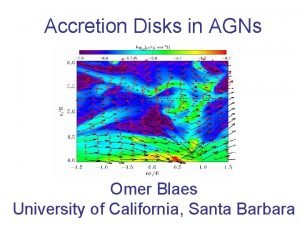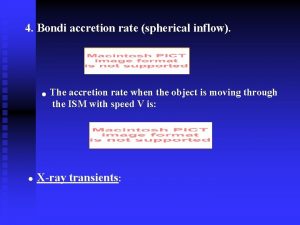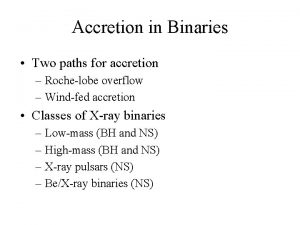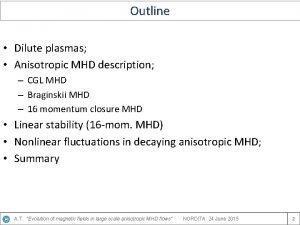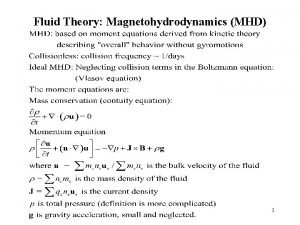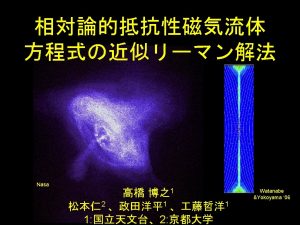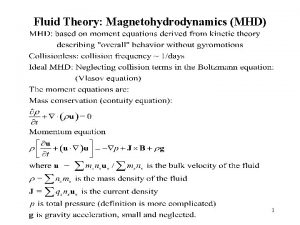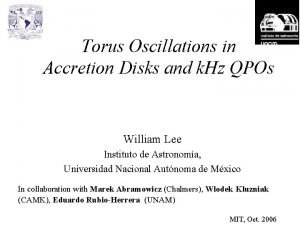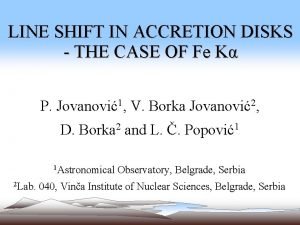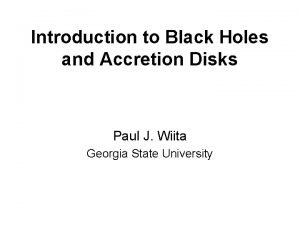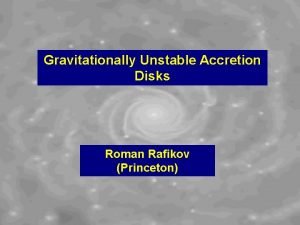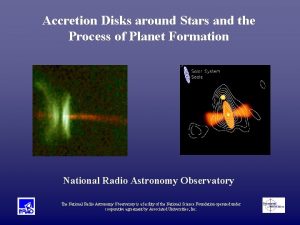MHD of Cold Accretion Disks VINOD KRISHAN University
































































- Slides: 64

MHD of Cold Accretion Disks VINOD KRISHAN University Of Tokyo, Kashiwanoha On leave from Indian Institute of Astrophysics, Bangalore, India

Collaboration

Accretion Disks arise when material , usually gas, is being transferred from one celestial object to another. "accretion" means collecting of additional material. Three major places where accretion disks are seen : in binary star systems , two stars orbiting each other and In Active Galactic Nuclei, around Black Holes. Star and Planet forming regions.

Protostellar and Protoplanetary Disks

Planet formation has been known for many years to be tied to the accretion and evolution of gas and dust in disks around young stars.

A great cloud of gas and dust (called a nebula) begins to collapse because the gravitational forces that would like to collapse it overcome the forces associated with gas pressure that would like to expand it (the initial collapse might be triggered by a variety of perturbations---a supernova blast wave, density waves in spiral galaxies, etc

In the Nebular Hypothesis, a cloud of gas and dust collapsed by gravity begins to spin faster because of angular momentum conservation

Because of the competing forces associated with gravity, gas pressure, and rotation, the contracting nebula begins to flatten into a spinning pancake shape with a bulge at the center

Condensation of Protosun and Protoplanets As the nebula collapses further, instabilities in the collapsing, rotating cloud cause local regions to begin to contract gravitationally. These local regions of condensation will become the Sun and the planets, as well as their moons and other debris in the Solar System While they are still condensing, the incipient Sun and planets are called the protosun and protoplanets, respectively

Disks In Binary Star Systems

B I N A R Y S T E M Our Sun is unusual in that it is alone - most stars occur in multiple or binary systems. In a binary system, the higher mass star will evolve faster and will eventually become a compact object - either a white dwarf star, a neutron star, or black hole. When the lower mass star later evolves into an expansion phase, it may be so close to the compact star that its outer atmosphere actually falls onto the compact star

If one star in a binary system is a compact object such as a very dense white dwarf star and the other star is a normal star like the sun, the white dwarf can pull gas off the normal star and accrete it onto itself. Since the stars are revolving around each other and since the ANGULAR MOMENTUM must be conserved, this gas cannot fall directly onto the white dwarf, but instead spirals in to the white dwarf much like water spirals down a bathtub drain.

Thus material flowing from the normal star to the white dwarf piles up in a dense spinning accretion disk orbiting the white dwarf. WD N The gas in the disk becomes very hot due to friction and being tugged on by the white dwarf and eventually loses angular momentum and falls onto the white dwarf. Since this hot gas is being accelerated it radiates energy, usually in X-Rays which is a good signatures to identify and study accretion disks

The origin of doublehorned structure, for an accretion disk in a binary. Gas in each zone of the disk is coming toward, or receding from us with a similar velocity (they have very different sideways motion but that does not matter for Doppler shifts). Adding up contribution of all the gas in each zone, we can calculate the emission line profile -- the result is a characteristic double-horned shape

Accreting Binaries systems can have very large separations, in which case the period, by Kepler's laws, is long. Some binaries have separations that are comparable in size to the stars themselves, however. Such systems are called close binaries. In close binaries the orbital period is small, and because the stars are so close together, matter may stream from one star onto the other star. These are called accreting binaries, and they lead to a broad range of very interesting phenomena.

One member of the binary is a neutron star and it has a less-massive white-dwarf star companion. Matter appears to be accreting from the white dwarf onto the neutron star.

Binary accretion can be illustrated by plotting contours of equal gravitational potential. The center of mass is marked with an "x". The point labeled L 1 is called the inner Lagrange point; it is a point where the net gravitational force vanishes. Roche Lobes and Mass Accretion This contour defines two regions, one around each star, called Roche lobes. Mass accretion can occur if one of the stars fills its Roche lobe, allowing matter to spill over the inner Lagrange point onto the other star.

Wind Driven Accretion in binary systems can also take the form of a wind from the surface of one star, as opposed to a thin accretion stream flowing through the inner Lagrange point. Then the second star accumulates matter from the first star as it moves on its orbit through this wind. In complex situations, both winds and tidal accretion streams may play a role

Neutron star explosion reveals inner accretion disk. A massive and rare explosion on the surface of this neutron star -- pouring out more energy in three hours than the Sun does in 100 years -- illuminated the region and allowed the scientists to spy on details never before revealed. Published: February 23, 2004

The formation of a disk need not halt the infall. But once formed, it is the disk itself that mediates continued accretion. And the physical processes that regulate mass inflow will generally be very different in character from those that may have triggered the initial infall

Accretion disks can be separated into three broad categories: (a) protostellar disks, where stars and planets form; (b) disks formed by mass transfer in binary star systems, e. g. , novae and compact x-ray sources; and (c) disks in active galactic nuclei (AGN). Accretion Disks could be highly Ionized , Hot and Collisionless e. g. Around Black Holes. Accretion disks could be weakly Ionized , Cold and Collisional e. g. Protoplanetary Disks TURBULENT ? Usually Magnetized

Accretion Disks offer novel and efficient ways of extracting the Gravitational Energy A blob of gas in an orbit around a central gravitating body will stay in that orbit. If we then remove Energy and Angular Momentum from the blob, it will spiral inwards. With this mechanism, the binding Energy of its innermost orbit can be extracted. The Matter can move in only if the Angular Momentum moves out The Sun has the most mass and the planets the most of the angular momentum!

Efficiency of Conversion, ( Hydroelectric Power!) Gravitation to Light Luminosity Efficiency White Dwarf, M=Msun, R= 1000 Km, 0. 1% Neutron Star, M=Msun, R= 10 Km. , 10 % Black Holes, 10% Thermonuclear Reactions H burn, 0. 7%, heavy elements, 0. 1%

Density and temperature scales The range of densities and temperatures both within disks and from disk to disk is enormous. Disks occupy the broad density scale gap between interstellar matter, which is at most 10^6 cm^-3 in molecular cloud cores, and stellar interiors, have typically 10^25 cm^-3 .

Disks in binary systems generally have interior densities above 10^15 cm^-3 but well below the stellar regime. Considerable radiation comes from the disk atmosphere, which will typically have a density less than 10^15 cm^-3 but well above the molecular cloud core value. The innermost regions of an accretion disk can be very hot.

The innermost regions of an accretion disk can be very hot. If 10^37 ergs /s is emerging from a gas disk over a region of radial dimension 10^6 cm (i. e. , neutron star dimension) and the gas is emitting as a blackbody, then its temperature will be of order 10^7 K. It will be a plentiful sourceof ke. V photons, as compact x-ray sources indeed are. The surface temperature decreases as one moves outward in the disk. The local luminosity of a disk scales as 1/r and the radiated flux as 1/r^3 , which implies an r^-3/4 scaling law for the surface temperature.

Thus, on scales of 10^10 cm , the fiducial disk will have cooled to 10^4 K. Disks around white dwarfs get no hotter than 10^5 K or so in their innermost orbits, and they ought not to be powerful x-ray sources. This is the general picture. However, the physics of the accretion process becomes complex very near the stellar surface where such phenomena as standing shock waves are possible and harder x-rays may originate in such processes. A rich variety of eruptive outbursts are associated with white dwarf accretion.

Equilibrium Model Rotating mass of gas in a cylindrically symmetric Potential Well of a point mass at the origin, the centre of the disc Axis of Symmetry parallel to the Angular Momentum Vector Radial component of the force balance Keplerian Motion Vertical Structure Thin Disk

Equilibrium Model The azimuthal component of the force balance Describes conservation of the angular momentum in the absence of viscous forces For Thus additional torque is required to transfer angular momentum outwards and consequently mass flow inwards

Transport of the angular momentum Infall Averaged over the vertical direction, in the steady disk, a constant inward flux Search for shear stress T and viscosity coefficient, AND INSTABILITIES , AND TURBULENCE

Time Scales At a given radius Shortest Disk time scale By the rotation angular frequency Time scale over which the hydrostatic equilibrium is established in the vertical direction Time scale over which surface density changes, the viscous time scale

Normalizations

Magnetohydrodynamics of Differentially Rotating Fully Ionized Plasmas Curl of the Eq. Of motion The Induction Eq. The Continuity Eq. And

The Equilibrium in Cylindrical Geometry

Possibility Of A Hydrodynamic Instability Perturb the system with And linearize Solve for Conclusion: Instability if the specific angular momentum is a decreasing function of the radial position So, Keplerian rotation is stable! Even though

Magnetorotational Instability (Balbus & Hawley, 1991) Assumptions: Perturbations only in the plane of the disk of the form The linearized Eqs. Force balance Induction Eq. Dispersion relation

And derive the critical stability condition For Instability For the Keplerian Rotation Determines the maximum magnetic field. The maximum growth rate is determined with respect to k from To be

BUGS! Divergence Conditions Violated with the form Differentially rotating system is a nonautonomous system, cannot be Fourier analyzed as has been done by taking perturbations of the form Recovery of the Rayleigh Criterion for B=0 Local Treatment ? Radial variation is the basis of the instability, should it be ignored? Existence of the mode has not been investigated, only the instability conditions.

Some of these bugs can be removed, e. g. by retaining radial and or azimuthal variations but one still remains within the limitations of the local treatment Rayleigh Criterion can be easily recovered from the plus root of the quartic The minus root is identified with the MRI A lot of work since 1991, including Non. Ideal effects, such as the Hall effect, the dissipation and the ambipolar diffusion has been done. These are particularly important in weakly ionized accretion disks. But most of the work has the same bugs.

The Magnetrotational Instability, Does it Exist in Keplerian disks ?

Weakly Ionized Rotating Plasmas

Weakly Ionized Plasmas are found in several astrophysical objects such as in circumstellar, and protoplanetary Disks. Because gas clouds have difficulty getting rid of excess angular momentum during a phase of dynamical collapse, there is reason to believe that all stars form with some sort of (accretion) disk surrounding them. Observing the formation and evolution of circumstellar disks is crucial for understanding the star formation and planet-building processes. If a disk becomes sufficiently massive, compared to the central object that it surrounds, a gravitational instability in the system may cause the disk to accumulate into an off-axis, binary companion of the central object or to break into two or more pieces.

These disks are: ~ 100 AU in radius, tens to a few AU thick, of masses ~ 0. 1 solar mass. If 0. 01 Msun is spread over a cylinder of radius 1 and height 0. 01 AU, this would have a mass density 10^(-10)gm cm-3.

Other charachteristics Total neutral number density Magnetic field ~ 50 micro. Gauss Ionization Fraction ~ 10^(-4) - 10^(-7),

Couplings Electron neutral collision frequency Resistivity Ion-neutral collision frequency

THE MHD and THE HALL-MHD The Three –Fluid Model ELECTRON EQ. For Inertialess electrons (m_e = 0 ) ,

The Inertialess Ion Eq. Substitute for E from the inertialess electron eq. To find for AND

Neutral Fluid Dynamics Substituting for the velocity differences Behaves like a charged fluid due to strong coupling with the charges

The Induction Equation Substituting for V’s I H A For typical parameters in protostellar disks O

Normalizations

Hall-MHD of Rotating Disks Curl of the Eq. Of motion of the neutral fluid (dimensionless) The Induction Eq. The Continuity Eq. And

The Equilibrium in Cylindrical Geometry

Perturb the system with LINEAR NONLINEAR

Linear system Solve with Balbus & Terquem, (Ap. J. 552, 247, 2001 ) assume This again violates divergence conditions

Linear Analysis for uniform rotation

Or So that With the solution And Alfven limit Hall limit

For And eigenfunctions as the Chandrasekhar-Kendall functions:

The Dispersion Relation is: is the radial wavenumber

To see if exists Write the components of the eigenvalue equation for d/dr=0 The only consistent solution is: With the corresponding dispersion relation

Dispersion Relation Balbus and Terquem Ap. J. 552, 247, 2001 Thus Does not exist !! Consequences e. g. Nature of the Hall instability changes

Exact Nonlinear Solution Recall LINEAR NONLINEAR Linear relations Nonlinear terms vanish!

Conclusion Hall- MHD of a weakly ionized uniformly rotating plasma submits to an exact nonlinear solution representing waves of arbitrary amplitude with dispersion relation: And eigenfunctions as C-K functions

Inclusion of Resistivity along with the Hall Effect The dispersion Relation is Linear damping of nonlinear waves Again with m=1 for radially symmetric eigenfunction In contrast to Nonlinear damping of linear waves For heating and ionization purposes

Summary Exact nonlinear solution of incompressible resistive Hall MHD of partially ionized uniformly rotating plasmas has been found.
 Shaily krishan
Shaily krishan History of latin american city model
History of latin american city model Accretion expense
Accretion expense Syncline
Syncline Zone of in situ accretion
Zone of in situ accretion Standing accretion shock instability
Standing accretion shock instability Accretion
Accretion Accretion
Accretion Accretion disk corona
Accretion disk corona Mhd alyssa
Mhd alyssa Describe
Describe Introduction to mhd
Introduction to mhd Mhd power generation ppt
Mhd power generation ppt Mhd titel
Mhd titel Astrophysics equations
Astrophysics equations Mhd
Mhd Fcis lms
Fcis lms Ballooning
Ballooning Adv vinod sampat
Adv vinod sampat Vinod ganapathy iisc
Vinod ganapathy iisc Dma directions
Dma directions Simsonattribut
Simsonattribut Byzantine reliable broadcast
Byzantine reliable broadcast Ca vinod jain
Ca vinod jain Vinod panicker
Vinod panicker Aorldw
Aorldw Vinod bidwaik
Vinod bidwaik Parindopril
Parindopril Vinod kurup
Vinod kurup Vinod dhall
Vinod dhall Welcome 1 unit 10 lesson 1
Welcome 1 unit 10 lesson 1 Tower of hanoi 4 disks
Tower of hanoi 4 disks Raid redundant array of independent disks
Raid redundant array of independent disks Computer parts labeling
Computer parts labeling Types of floppy diskette
Types of floppy diskette Output device
Output device Fixed-head magnetic disk storage
Fixed-head magnetic disk storage Redundant arrays of independent disks
Redundant arrays of independent disks Probability learning objectives
Probability learning objectives Azure vm ssd
Azure vm ssd Disks and tapes can be stored ------- a library. eng101
Disks and tapes can be stored ------- a library. eng101 Unraid nedir
Unraid nedir Holger brock
Holger brock Conquest data disks
Conquest data disks 詹景裕
詹景裕 Cold sauces
Cold sauces Cool chilly cold freezing
Cool chilly cold freezing Personification for cold wind
Personification for cold wind Base spread filling
Base spread filling Acrostic poem
Acrostic poem Operation rolling thunder cold war
Operation rolling thunder cold war Epley manuveur
Epley manuveur Rombergs test
Rombergs test Conclusion of cold chain
Conclusion of cold chain Unit 3 weather
Unit 3 weather Air mass drawings
Air mass drawings How does cold front form
How does cold front form Absorption bases example
Absorption bases example Compare and contrast cold wave and wind chill factor
Compare and contrast cold wave and wind chill factor Cold war
Cold war Peep under the iron curtain
Peep under the iron curtain It's windy weather it's stormy weather
It's windy weather it's stormy weather Operation rolling thunder cold war
Operation rolling thunder cold war The causes of the cold war
The causes of the cold war Now listen well as a tale i tell
Now listen well as a tale i tell



